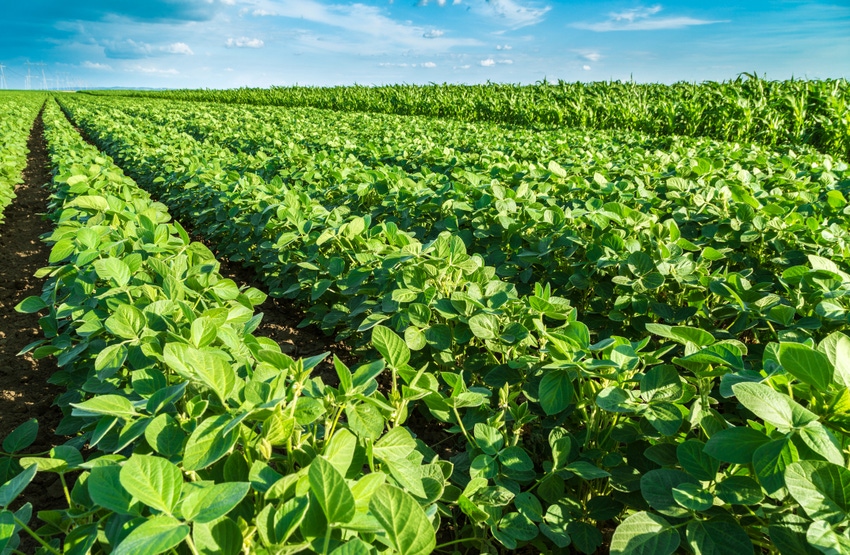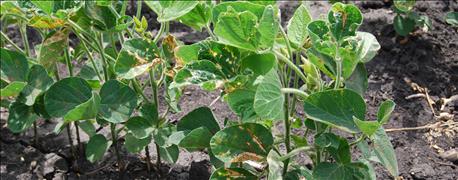April 4, 2016

Each new growing season presents soybean producers with tests that affect the bottom line. One of those challenges can be disease pressure. Fungal infections on soybean plants limit yield potential. This makes it even more important to efficiently identify and diagnose properly.
According to Iowa State University, diseases are typically identified via visible symptoms on plants. Looking for changes in color, shape and/or function of the plant in response to a pathogen can help you identify issues. Leaf spots or blights, discoloration of plant tissue as well as stunting and wilting can also indicate an infection.
|
DISEASE TRIANGLE: A susceptible host plant, a pathogen and a favorable environment are the three factors composing the plant disease triangle. All three are necessary for development of a plant disease. Disease can be affected by altering any of the three factors. |
Finding the problem
Before you can fix an issue, it’s important to know how to accurately recognize common issues and limit their damage. Here are common soybean diseases and symptoms:
Frogeye Leaf Spot: Frogeye leaf spot is a serious disease annually affecting soybean growers. According to Nathan Kleczewski, Extension Plant Pathologist at the University of Delaware, frogeye leaf spot can cause more than 30% yield loss if not properly managed. Symptoms to identify are:
•Brown, grey or tan spots with dark brown or purple boarders
•A layered appearance when leaves are young
•Under severe disease pressure lesions may combine and cause leaf drop
•Stems with dark red to brown spots
White Mold: Purdue University discovered that for every 10% of white mold found in soybean infections during R7 can lead to yield loss from 2 to 5 bushels per acre. Infection is common during flowering under a wet, cool canopy. This occurs most commonly early in the season, but can redevelop later in the season as the summer’s heat recedes. Easy signs to look for include:
•White, fluffy, cottony growth on the outside of the stem and on the pods
•Wilted leaves and stems that appear bleached, along with tearing of the stem tissue
•Sclerotia (hard and dark fungal masses) can also be found on and inside plants that have been infected by white mold
Brown Spot (Septoria Leaf Spot)
Brown spot thrives during cooler, wet conditions. If left unchecked, it can damage plant leaves and stunt pod fill. Signs include:
•Brown or black spots on plant leaves that are angled or include a yellow ring or halo around spots
•Late season infections force leaves to turn yellow and defoliate from plants prematurely
For help identifying a variety of other diseases in soybeans, please see the full catalogue from Iowa State University Agronomy Extension.
How does one combat these diseases?
Randy Myers, product development manager for Bayer, says that growers looking to limit damage from soybean diseases need to be aware of their fungicide application timing. “Timely fungicide applications will be your best defense. The most effective applications for most diseases will come around beginning of pod set, or about R3. White mold is an exception, however, as first applications need to be made at flowering, or R1, because blossom petals are the typical medium for infection. A second application around R3 is usually needed to get the full benefits of the treatments.”
“Applying a product like Stratego YLD fungicide around R3 can help limit a lot of damage from common diseases like brown spot or frogeye leaf spot,” said Myers. “With a single application at this timing, trials have shown yields improve on average about 3.25 bushels per acre.”
Along with timely applications, Farm Progress reports that scouting should happen before R3 growth stage, especially if weather has been rainy and/or humid. These types of conditions prove to be particularly favorable to foliar disease.
Additionally, the Department of Plant Pathology and Microbiology at Iowa State University determined that “the yield response of soybeans was greater with an R3 application rather than an R1 application. So, an R3 application of a fungicide was more likely to break even than an R1 application. Although these data suggest that nearly 60% to 70% of R3 applications of a fungicide containing a strobilurin at least break even, spraying when disease is present will further increase your chances of getting your money back.”
Don’t let soybean disease and insect pests limit your yield potential. Learn how to prevent damage from these other articles:
•Anthracnose Sneaks Up on Soybeans
About the Author(s)
You May Also Like





